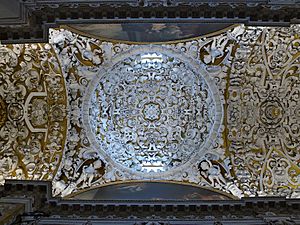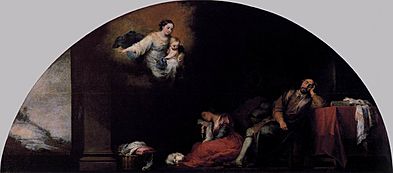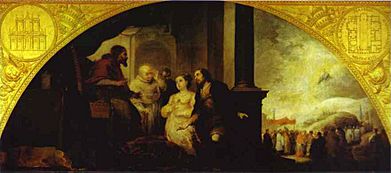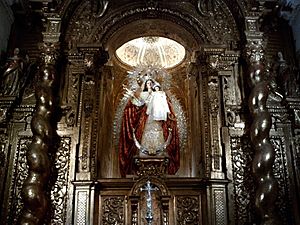Church of Santa Maria la Blanca (Seville) facts for kids
Quick facts for kids Church of San Maria la Blanca |
|
|---|---|
|
Assets of cultural interest
|
|
 |
|
| Religion | |
| Affiliation | Catholic |
| District | Seville |
| Province | Seville |
| Leadership | Father Miguel Ángel Núñez Aguilera |
| Location | |
| Location | Andalucia, Spain |
| Architecture | |
| Architectural type | Church |
| Architectural style | Borrominesque |
| Funded by | 17th century |
| Inscriptions | Cultural monument on July 25, 1995, November 15, 1995, and June 12, 1995 |
The Church of Santa María la Blanca (which means Saint Mary the White Church in Spanish) is a beautiful old church in the San Bartolomé area of Seville, Andalusia, Spain. It was built a long time ago in the 1600s. Today, it is the main home for a special group called the Brotherhood of the Rosary of Our Lady of the Snows.
Contents
History of the Church
From Ancient Times to a Synagogue
The spot where the church stands has a very long history. Before the church, there was an even older building from the time of the Visigoths, who ruled Spain many centuries ago. You can still see two old columns with special carvings from the Visigothic period on the south side of the church.
In 1248, after the city of Seville was taken back by Christian forces in the Reconquest of Seville, King Ferdinand III gave most of the city's mosques to the Catholic Church. However, he gave three mosques in the Jewish quarter to the Jewish people to use as their synagogues. This was confirmed by King Alfonso X in 1252. The Church of Santa María la Blanca was built on the site of one of these synagogues, which was built in the 1200s. Sadly, no parts of that original synagogue remain today.
Becoming a Christian Church
In 1391, after some difficult events where Jewish communities faced attacks, this synagogue was changed into a Christian church. It was built in a style called Gothic-Mudejar, which mixes European Gothic and Islamic Mudejar designs. During this change, a new front part of the church was built. In 2024, during some repair work, parts of the synagogue's torah ark (a special cabinet where holy scrolls were kept) were found.
More parts of the church were added over time. The chapel for baptisms was built in 1642. Between 1642 and 1646, a chapel for a special brotherhood was built on top of an old house next to the church. The main chapel was finished in 1660. Then, from 1662 to 1665, the main part of the church and its ceilings were rebuilt.
Rebuilding and Art in the 1600s
In 1662, a person named Justino de Neve hired Juan González to build the church's new ceilings. The plan included a large central ceiling with curved sections and a dome. They also replaced the old stone columns with new ones made of beautiful jasper stone from quarries in Antequera.
The detailed plasterwork (decorative designs made from plaster) on the central ceiling and the dome were created by artists named Borja and Pedro Roldán. The big rebuilding project in the 1600s was paid for by money collected by Justino de Neve, who was a member of a church brotherhood.
In 1665, to celebrate the newly renovated church, a special parade was organized. The church also underwent a restoration process between 2010 and 2015 to keep it in good condition.
What the Church Looks Like
Outside the Church
The Church of Santa María la Blanca has two smaller entrances on the outside.
The main entrance faces Santa María la Blanca street. It has a tall, pointed arch at the bottom, decorated with diamond shapes carved into the stone. Above this, there are three sections. The first has two simple arched openings. The next section holds the church bells, with two arched openings framed by pillars. The very top has a small bell tower with one arched opening, decorated with ceramic pieces and a cross. To the right of the main door, there is a colorful tile with a picture of the Virgin of the Snows, painted in 1957.
On the side wall, facing Archeros Street, there is another doorway. This door is not used anymore, but it was likely the original entrance to the church. It has a rounded arch with a solid stone panel above it, placed between two columns. The tops of these columns have special carvings that might be from the late Roman or Visigothic times.
Inside the Church
The inside of the church was decorated in 1657 by two brothers, Pedro and Miguel de Borja. The church has a rectangular shape, with a longer area for the altar and two other rectangular sections attached to the side wall. Inside, there are three long aisles, separated by 10 columns made of red marble. These columns support rounded arches that hold up the ceilings. The central aisle has barrel vaults (rounded ceilings) with false curved windows, while the side aisles have groin vaults (cross-shaped ceilings).
Above the last two sections of the central aisle, near the altar, there is a large dome resting on pendentives (curved triangle shapes that help support a round dome on a square base). This dome is lit by two round windows on the sides. The area around the main altar also has a barrel vault ceiling with curved windows.
The entire surface of the ceilings, dome, and the inside of the arches are covered with rich and detailed plasterwork. These decorations include geometric shapes, plants, and figures. Along with paintings on the walls, these designs make the church's interior feel lively and moving, even though its basic shape is very straight.
At the end of the right-hand aisle is the baptismal chapel, where you can find the stairs leading to the bell tower and the choir area. Next to it is the sacramental chapel, which is also rectangular. Further along the same aisle is the sacristy, where priests prepare for services.
The sacramental chapel has a main altar piece from 1722. It features a scene of Calvary (Jesus on the cross) with different statues. The statue of Christ of the Mandate was made in 1559 from wood paste. The Virgin of the Pópulo is a dressed statue of Mary in sorrow, which has been in this church since 1610. It was repaired in 2021 and wears a silver crown made in the 1700s. The statue of Saint John is thought to be the work of Cristóbal Ramos after it was repaired in 2017.
The church once had several famous paintings by Murillo. Today, only one, The Supper (painted in 1650), remains in the church. Two other famous paintings by Murillo, The Dream of the Patrician and The Patrician John and his wife before Pope Liberius, which told the story of how devotion to the Virgin of the Snows began, were taken during the French invasion. They were later returned to Spain and are now in the Prado Museum. Other Murillo paintings, like an Immaculate Conception and The Triumph of Faith, are now in other museums and collections around the world.
Other important paintings are still in the church. The altarpiece of the Pietà, from 1564, includes works by Luis de Vargas. A painting of the Ecce Homo was made by an artist who followed the style of Luis de Morales.
The Main Altar
In 1657, a church official named Canon Justino de Neve announced that he had collected money to build a new main altarpiece (the decorated screen behind the altar). On August 31, 1657, Martín Moreno, a master craftsman who had already worked on the church's choir stalls, was hired to build it.
This altarpiece is in the Baroque style, which means it's very ornate and detailed. It has a beautifully carved base with flower designs. On the sides, there are statues of Saint Peter and Saint Paul, flanking a silver tabernacle (a small box where the Eucharist is kept). These statues are framed by pairs of columns. Above them, there are carvings of angels. Recently, a crucifix (a cross with a figure of Jesus) has been added, which is believed to have been made by Juan de Mesa around 1620.
Groups Connected to the Church
The Antigua y Fervorosa Hermandad del Rosario de María Santísima Nuestra Señora de las Nieves (which means Ancient and Devoted Brotherhood of the Rosary of Holy Mary Our Lady of the Snows) has its main home in this church. This is a "brotherhood of glory," meaning it focuses on devotion to a saint rather than penitence. Their first rules were written in 1732. The statue of the Virgin of the Snows was made in the 1800s by Juan de Astorga and has been with the brotherhood since 1864.
Another group, the Brotherhood of Penitence of the Church of San Isidoro, also honors the Virgin of the Snows as their patron saint.
The Brotherhood of the Lavatory, Christ of the Mandate, and the Mother of God of the Pópulo was founded in 1598. In 1610, it moved to the Church of Santa María la Blanca. This brotherhood used to have special processions with three floats. One float showed the washing of feet, another carried the Christ of the Mandate, and a third carried the Virgin of the Pópulo under a blue velvet canopy. The last recorded procession by this brotherhood was in 1662. Many important people belonged to this group, including Justino de Neve, the writer Fernando de la Torre Farfán, and noble families.
See also
 In Spanish: Iglesia de Santa María la Blanca (Sevilla) para niños
In Spanish: Iglesia de Santa María la Blanca (Sevilla) para niños





